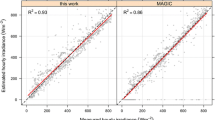Summary
Reflectances measured by the ‘visible’ channel of Meteosat are converted to global radiation at the ground by the Heliosat-algorithm. This algorithm is based on the inverse relationship between reflectance and transmittance. This relationship is, however, complicated by two factors: 1) the absorptance of the atmosphere is varying, and 2) the reflectivity is different in different directions. These two factors are again depending on the state of the atmosphere (mainly clouds) and the sun-ground-satellite geometry. The performance of the Heliosat-method is here tested against ground data from Bergen (Norway), Geneva (Switzerland) and Lyon (France), and analysed in light of cloud properties as observed from ground, and different sun-ground-satellite geometries. Situations where modelled and measured radiation differ are identified, and possible causes are suggested. Some of the suggestions are supported by calculations with a radiative transfer model.
Similar content being viewed by others
Author information
Authors and Affiliations
Rights and permissions
About this article
Cite this article
Dagestad, KF. Mean bias deviation of the Heliosat algorithm for varying cloud properties and sun-ground-satellite geometry. Theor Appl Climatol 79, 215–224 (2004). https://doi.org/10.1007/s00704-004-0072-5
Received:
Revised:
Accepted:
Published:
Issue Date:
DOI: https://doi.org/10.1007/s00704-004-0072-5




